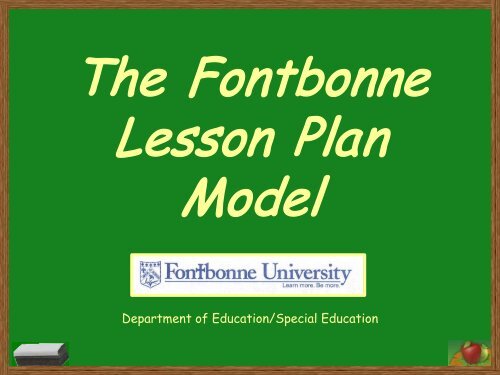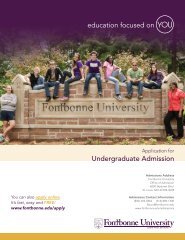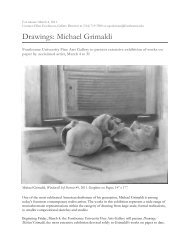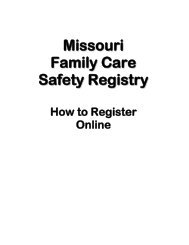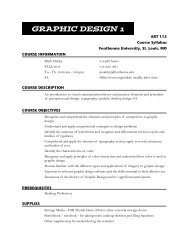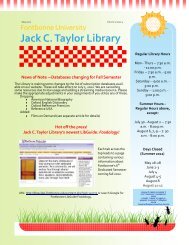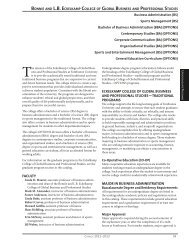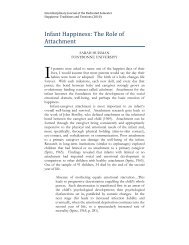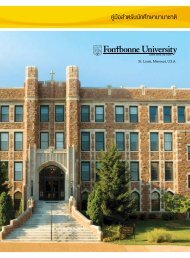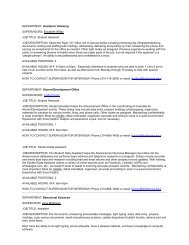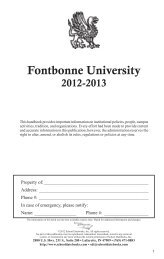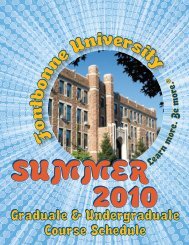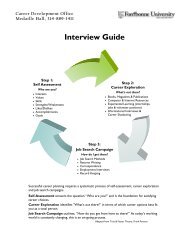The Fontbonne Lesson Plan Model
The Fontbonne Lesson Plan Model
The Fontbonne Lesson Plan Model
You also want an ePaper? Increase the reach of your titles
YUMPU automatically turns print PDFs into web optimized ePapers that Google loves.
<strong>The</strong> <strong>Fontbonne</strong><br />
<strong>Lesson</strong> <strong>Plan</strong><br />
<strong>Model</strong><br />
Department of Education/Special Education
<strong>The</strong> <strong>Fontbonne</strong> Department of<br />
Education/Special Education has developed a<br />
lesson planning model that will be used in all<br />
teaching methods classes, student teaching<br />
and your culminating project.<br />
<strong>The</strong> <strong>Fontbonne</strong> plan is based upon the<br />
contextual planning model. It is learner<br />
centered and promotes the design of learning<br />
environments that incorporate as many<br />
different learning styles as possible. Key<br />
elements are differentiation of instruction,<br />
assessment, and reflection.<br />
2
<strong>The</strong> <strong>Fontbonne</strong> <strong>Plan</strong><br />
Step 1: Prior knowledge<br />
• Determine what the students already know<br />
before the lesson.<br />
• Use a variety of assessment tools<br />
• Previous day – exit card, journal entry<br />
• Same day – grade homework, pre-test,<br />
individual KWL chart, individual concept map,<br />
question/problem of the day<br />
3
Step 2: Goals<br />
• Broad, generalized statements about what is to<br />
be learned. <strong>The</strong>y are the framework within<br />
which content, skills, processes and attitudes are<br />
taught.<br />
• Include Show-Me Standards (knowledge+<br />
performance)<br />
• Include Grade Level Expectations (GLE)<br />
Website: http://www.dese.mo.gov/divimprove/curriculum/GLE/<br />
Example: To introduce students to the meaning of<br />
history and its importance. (1.9; SS2,SS6, SS7; GLE<br />
SS6K,SS7C, SS7F)<br />
4
Step 3: Learner Outcomes<br />
• Specify what a student is expected to<br />
know/understand/be able to do as a result of the<br />
lesson.<br />
• Four-part outcome:<br />
Who will be performing.<br />
What the learner is expected to be able to<br />
do.<br />
Conditions under which the performance will<br />
occur.<br />
Criteria: measurable performance criterion<br />
that describes how well the student must<br />
perform in order to be considered acceptable.<br />
5
• Include two or more learner outcomes.<br />
• Include level of Bloom’s Taxonomy for each<br />
outcome.<br />
• Example: Working in small groups, the students<br />
will list three reasons, each with an appropriate<br />
example, why history is an essential element in<br />
understanding ourselves and the world. (SS2;<br />
GLE=SS3Y)<br />
6
Step 4: Assessment of learner outcomes<br />
• Measure what the students learned after the<br />
lesson has been taught.<br />
• Align assessments with outcomes and<br />
procedures and include Depth of Knowledge<br />
(DOK).<br />
• Utilize a variety of assessment tools to collect<br />
your assessment data.<br />
• Include differentiated assessments to meet<br />
different learning needs.<br />
• List the assessment tools/artifacts used to<br />
collect data for each learner outcome. (Include<br />
copies of all assessment tools after the lesson<br />
plan for each day.<br />
7
Step 5: Procedures<br />
• List what YOU, the teacher, will do to teach<br />
and ensure student learning.<br />
• Align procedures with outcomes and<br />
assessments.<br />
• Include differentiated teaching and learning<br />
strategies to meet diverse learning profiles.<br />
Differentiated Instruction<br />
One size does not fit all!<br />
Students come in different<br />
shapes and sizes with different<br />
interests, learning profiles and<br />
readiness levels.<br />
8
<strong>The</strong> teacher adjusts content,<br />
process and product in response to<br />
student readiness, interests and<br />
learning profiles.<br />
All students are exposed to key<br />
concepts, themes and common<br />
elements, but at differing levels<br />
of complexity and depth.<br />
All students are engaged in<br />
challenging tasks.<br />
9
• Use Gardner’s Multiple Intelligences for each<br />
activity.<br />
• Use Bloom’s Taxonomy in all questioning.<br />
Procedures Outline<br />
1. Introduction/anticipatory set<br />
a) Identify the “hook” to build interest<br />
b) Tie new learning to previous learning<br />
c) Explain what they will know and be able to<br />
do at the end of the lesson and why it is<br />
important in their lives.<br />
10
2. Identify the first teaching/learning strategy<br />
a) Details in outline form<br />
b) Identify differentiated teaching and<br />
learning strategies<br />
c) Identify how you will check for<br />
understanding among all students<br />
d) Identify any flexible grouping<br />
e) Identify teacher/student materials,<br />
technology or other resources and any<br />
necessary changes to room space<br />
3. Repeat #2 with each additional<br />
teaching/learning strategy<br />
11
4. Closure<br />
a) Identify how the teacher reinforces key<br />
concepts<br />
b) Identify how students recap what they<br />
have learned in this lesson<br />
Step 6: Reflection on lesson<br />
(Not to be completed until after lesson has been taught)<br />
• Write in narrative form.<br />
• Be specific – include concrete examples and<br />
insights you gained as a reflective practitioner.<br />
12
• Use at least one paragraph per discussion point<br />
listed below:<br />
1. Summarize your feelings about the lesson.<br />
Briefly describe:<br />
a) what went differently than planned.<br />
b) what you would do differently.<br />
c) how your differentiated instruction<br />
addressed student needs.<br />
d) how you addressed learning profiles,<br />
readiness and interests in your<br />
assessments.<br />
e) how your management of the classroom<br />
and student behavior affected learning.<br />
13
2. Analyze the data in narrative form and<br />
draw conclusions.<br />
a) What did the data from your grade book<br />
indicate about students’ mastery of the<br />
learner outcomes? Use numbers here.<br />
b)What did the data tell you about your<br />
effectiveness in teaching the lesson?<br />
c)How did the data influence your planning<br />
for the next lesson?<br />
14


